
Kingston Lacy is a country house and estate near Wimborne Minster, Dorset, England. It was for many years the family seat of the Bankes family who lived nearby at Corfe Castle until its destruction in the English Civil War after its incumbent owners, Sir John Bankes and Dame Mary, had remained loyal to Charles I.
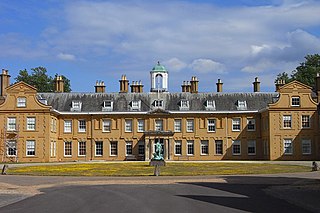
Stratfield Saye House is a large stately home at Stratfield Saye in the north-east of the English county of Hampshire. It has been the home of the Dukes of Wellington since 1817.
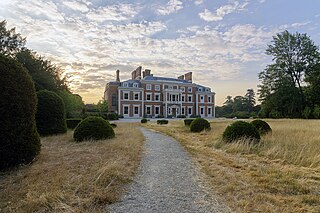
A country estate of 438 acres, the heart of Heckfield Place is a Georgian Grade II listed manor house, located in Hampshire, United Kingdom. It was built between 1763 and 1766 for Jane Hawley (1744–1815), it was enlarged by the Shaw Lefevre family who lived in the estate from 1786 to 1895. In the 20th century, it was owned by the family of Col Horace Walpole before being sold to Racal Electronics plc. and converted to a conference and training centre in 1981–1982.

Hursley is a village and civil parish in Hampshire, England with a population of around 900 in 2011. It is located roughly midway between Romsey and Winchester on the A3090. Besides the village the parish includes the hamlets of Standon and Pitt and the outlying settlement at Farley Chamberlayne.

Wynyard, sometimes known as Wynyard Hall, is a large English country house near Stockton-on-Tees in County Durham. The house was the English family seat of the Vane-Tempest-Stewart family, Marquesses of Londonderry, an Anglo-Irish aristocratic dynasty, until it was sold to Sir John Hall in 1987.
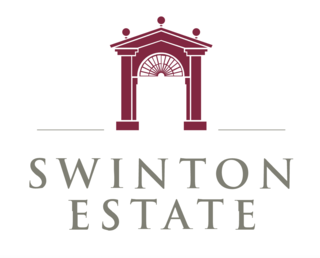
The Swinton Estate is a large privately owned estate in North Yorkshire, England. It comprises some 20,000 acres (8,100 ha) of countryside in the Nidderdale Area of Outstanding Natural Beauty, extending 10 miles (16 km) west from the River Ure near Masham. The estate includes Swinton Park, the seat of the Danby family and of the Cunliffe-Lister family, an English country house in Swinton near Masham. It is set in 200 acres (81 ha) of parkland, lakes and gardens. The house is a Grade II* listed building, and now operates as the 42-bedroom Swinton Park Hotel.

The River Whitewater rises at springs near Bidden Grange Farm between Upton Grey and Greywell in Hampshire, England. It flows northeast and is a tributary of the River Blackwater near Swallowfield. Its headwaters flow over chalk and there is little pollution making the River Whitewater rich in wildlife. It was noted on Jansson's map of Hampshire of 1646.

Great Fosters is a 16th-century mansion which originally lay within Windsor Great Park and is still adjacent to the town of Egham, Surrey, England. It is a Grade I listed building, close to Heathrow and the M25 London orbital motorway.
Heckfield is a village in Hampshire, England. It lies between Reading and Hook.

Eynsham Hall is a Grade II listed mansion near North Leigh in Oxfordshire, England. The original house dating from the 1770s was largely rebuilt in the early 20th century by Ernest George. After use as a country house and venue for hunting parties it became a maternity hospital rest and relaxation centre in World War II and then a police training centre. It is now used as a hotel and country club.

Redenham Park is an estate in the civil parish of Appleshaw, Hampshire, England, surrounding Redenham House, an 18th-century Grade II* listed country house.

Broadfield House is a 19th-century villa-style house in the Broadfield neighbourhood of Crawley, a town and borough in West Sussex, England. Built in 1830 on the extensive land of the Tilgate Estate south of the small market town of Crawley, it was extended later in the 19th century and converted into a country club. After World War II, Crawley was designated a New Town and had to prepare for rapid, strictly planned growth. Broadfield House was chosen as the headquarters of the Crawley Development Corporation, and became the base where all the decisions that shaped Crawley's future were made. The house, which is still set in parkland, was refurbished and converted for use by Discovery School in 2011. It has been listed at Grade II by English Heritage for its architectural and historical importance.
Beaurepaire is a country estate at Sherborne St John in the English county of Hampshire.

Haigh Hall is a historic country house in Haigh, Wigan, Greater Manchester, England. Built between 1827 and 1840 for James Lindsay, 7th Earl of Balcarres, it replaced an ancient manor house and was a Lindsay family home until 1947, when it was sold to Wigan Corporation. The hall is recorded in the National Heritage List for England as a designated Grade II* listed building and is owned by Wigan Council.
Burton Pynsent House is a historic country-house in the parish of Curry Rivel, Somerset, England. It is a Grade II* listed building. The house was built in stages between 1565 and 1765, when it was bequeathed to William Pitt, 1st Earl of Chatham by Sir William Pynsent, 2nd Baronet, who did not want the house to go to Lord North. Pitt had an additional wing built to a design by Lancelot Brown, and the subsequent owner demolished everything but this wing in 1805.

Cuerden Hall is a country mansion in the village of Cuerden near Preston, Lancashire, England. It is a Grade II* listed building. The Hall was formerly a family home between 1717 and 1906, and used by the Army until the 1960s. In 1985 it became a Sue Ryder neurological care centre. The Hall was sold to Manchester business man Colin Shenton in 2020 who is restoring it to its original purpose as a family home. The parkland and wider estate are known as Cuerden Valley Park. Cuerden Valley Park is now owned and managed by Cuerden Valley Park Trust which was a charity established in 1986, to ensure the longevity and management of the parkland itself. The Trust is made up for 650 acres of land; 1 reservoir, 15 ponds, 3 reed beds; over 5km of the river Lostock and 5 nature reserves.
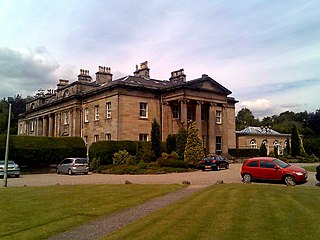
Balbirnie House is an early 19th-century country house in Glenrothes, in central Fife, Scotland. The present house was completed in 1817 as a rebuild of an 18th-century building, itself a replacement for a 17th-century dwelling. The home of the Balfour family from 1640, the house was sold in 1969 and opened as a hotel in 1990. The grounds now comprise a large public park and a golf course. The house is protected as a category A listed building, while the grounds are included in the Inventory of Gardens and Designed Landscapes in Scotland.
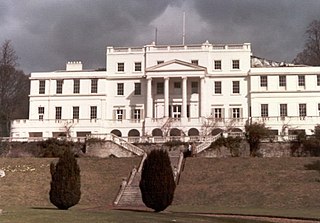
Linton Park, formerly Linton Place or Linton Hall, is a large 18th-century country house in Linton, Kent, England. Built by Robert Mann in 1730 to replace a much earlier building called 'Capell's Court', the estate passed through the ownership of several members of Mann's family before coming into the Cornwallis family. The house was enlarged to its current size in 1825.

Gisburne Park is an 18th-century country house and associated park in Gisburn, Lancashire, England, in the Ribble Valley some 6 miles (10 km) north-east of Clitheroe. The house is a Grade I listed building, and is now privately owned by Amber and Guy Hindley. The associated 1,000 acre park is Grade II listed, and is partly traditional agricultural estate and partly a holiday and wedding destination.

Dogmersfield Park or Dogmersfield House is a Grade I listed Georgian country house, now being used as a hotel. It is located in Dogmersfield, a small village in Hampshire, England. The land was recorded in the Domesday Book of 1086 as "Doccemere feld".

















